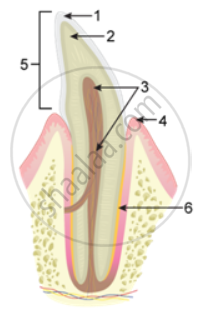Advertisements
Advertisements
Question
Study the diagram given below and then answer the question that follows:

Give the total number of the type of tooth mentioned in '1' above, in the mouth of an adult and state its function.
Solution
Type of teeth in the mouth of an adult:
- Incisors (8) → Used for biting and cutting
- Canines (4) → Used for holding and tearing of food
- Premolars (8) → Used for grinding and crushing of food
- Molars (12)→ Used for grinding and crushing of food
APPEARS IN
RELATED QUESTIONS
The stomach releases hydrochloric acid and ______ juices which act on food.
Match the items of Column I with suitable items in Column II.
| Column I | Column II | ||
| (a) | Salivary gland | (i) | Bile juice secretion |
| (b) | Stomach | (ii) | Storage of undigested food |
| (c) | Liver | (iii) | Saliva secretion |
| (d) | Rectum | (iv) | Acid release |
| (e) | Small intestine | (v) | Digestion is completed |
| (f) | Large intestine | (vi) | Absorption of water |
| (vii) | Release of faeces |
What is the special name of the contraction and expansion movement which pushes the food further in our digestive tract (or alimentary canal)?
What are the end products of the digestion of: starch, proteins and fats respectively?
Study the diagram given below and then answer the question that follows:

Describe the structure of the part labelled '3'.
Answer in detail.
Name the four types of teeth and their functions
State whether the following statements are True or false: Na+ is absorbed in intestine by sodium pump.
Name the enzymes secreted by the following: Salivary glands
What makes respiration and blood circulation go on all the time, and the processes of digestion happen at the right time?

Label the following parts in Figure 2.2 and name them.
- The largest gland in our body.
- The organ where protein digestion starts.
- The organ that releases digestive juice into the small intestine.
- The organ where bile juice gets stored.
